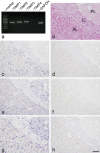Maintenance of the Extracellular Matrix in Rat Anterior Pituitary Gland: Identification of Cells Expressing Tissue Inhibitors of Metalloproteinases
- PMID: 26855451
- PMCID: PMC4726572
- DOI: 10.1267/ahc.15020
Maintenance of the Extracellular Matrix in Rat Anterior Pituitary Gland: Identification of Cells Expressing Tissue Inhibitors of Metalloproteinases
Abstract
The extracellular matrix (ECM) is important in creating cellular environments in tissues. Recent studies have demonstrated that ECM components are localized in anterior pituitary cells and affect cell activity. Thus, clarifying the mechanism responsible for ECM maintenance would improve understanding of gland function. Tissue inhibitors of metalloproteinases (TIMPs) are endogenous inhibitors of matrix metalloproteinases and participate in ECM degradation. In this study, we investigated whether cells expressing TIMPs are present in rat anterior pituitary gland. Reverse transcription polymerase chain reaction was used to analyze expression of the TIMP family (TIMP1-4), and cells producing TIMPs in the gland were identified by using in situ hybridization. Expression of TIMP1, TIMP2, and TIMP3 mRNAs was detected, and the TIMP-expressing cells were located in the gland. The TIMP-expressing cells were also investigated by means of double-staining with in situ hybridization and immunohistochemical techniques. Double-staining revealed that TIMP1 mRNA was expressed in folliculostellate cells. TIMP2 mRNA was detected in folliculostellate cells, prolactin cells, and thyroid-stimulating hormone cells. TIMP3 mRNA was identified in endothelial cells, pericytes, novel desmin-immunopositive perivascular cells, and folliculostellate cells. These findings indicate that TIMP1-, TIMP2-, and TIMP3-expressing cells are present in rat anterior pituitary gland and that they are involved in maintaining ECM components.
Keywords: anterior pituitary; extracellular matrix; immunohistochemistry; in situ hybridization; tissue inhibitor of metalloproteinases.
Figures




Similar articles
-
Tissue inhibitors of metalloproteinase-expressing cells in human anterior pituitary and pituitary adenoma.Med Mol Morphol. 2017 Sep;50(3):145-154. doi: 10.1007/s00795-017-0155-x. Epub 2017 Mar 28. Med Mol Morphol. 2017. PMID: 28353090
-
Rat pancreatic stellate cells secrete matrix metalloproteinases: implications for extracellular matrix turnover.Gut. 2003 Feb;52(2):275-82. doi: 10.1136/gut.52.2.275. Gut. 2003. PMID: 12524413 Free PMC article.
-
Alteration of Extracellular Matrix Components in the Anterior Pituitary Gland of Neonatal Rats Induced by a Maternal Bisphenol A Diet during Pregnancy.Int J Mol Sci. 2021 Nov 23;22(23):12667. doi: 10.3390/ijms222312667. Int J Mol Sci. 2021. PMID: 34884472 Free PMC article.
-
The role of TIMPs in regulation of extracellular matrix proteolysis.Matrix Biol. 2015 May-Jul;44-46:247-54. doi: 10.1016/j.matbio.2015.03.005. Epub 2015 Mar 21. Matrix Biol. 2015. PMID: 25805621 Review.
-
Regulation of ovarian extracellular matrix remodelling by metalloproteinases and their tissue inhibitors: effects on follicular development, ovulation and luteal function.J Reprod Fertil Suppl. 1999;54:367-81. J Reprod Fertil Suppl. 1999. PMID: 10692869 Review.
Cited by
-
Expression of Retinaldehyde Dehydrogenases in the Pituitary Glands of Fetus and Adult Mice.Acta Histochem Cytochem. 2024 Jun 28;57(3):109-118. doi: 10.1267/ahc.24-00018. Epub 2024 Jun 15. Acta Histochem Cytochem. 2024. PMID: 38988691 Free PMC article.
-
Renewing an old interest: Pituitary folliculostellate cells.J Neuroendocrinol. 2021 Nov;33(11):e13053. doi: 10.1111/jne.13053. Epub 2021 Nov 3. J Neuroendocrinol. 2021. PMID: 34734454 Free PMC article. Review.
-
Notch Signaling and Maintenance of SOX2 Expression in Rat Anterior Pituitary Cells.Acta Histochem Cytochem. 2017 Apr 27;50(2):63-69. doi: 10.1267/ahc.17002. Epub 2017 Apr 15. Acta Histochem Cytochem. 2017. PMID: 28522881 Free PMC article.
-
Tissue inhibitors of metalloproteinase-expressing cells in human anterior pituitary and pituitary adenoma.Med Mol Morphol. 2017 Sep;50(3):145-154. doi: 10.1007/s00795-017-0155-x. Epub 2017 Mar 28. Med Mol Morphol. 2017. PMID: 28353090
-
The astroglial and stem cell functions of adult rat folliculostellate cells.Glia. 2023 Feb;71(2):205-228. doi: 10.1002/glia.24267. Epub 2022 Sep 12. Glia. 2023. PMID: 36093576 Free PMC article.
References
-
- Beaulieu E., Kachra Z., Mousseau N., Delbecchi L., Hardy J. and Béliveau R. (1999) Matrix metalloproteinases and their inhibitors in human pituitary tumors. Neurosurgery 45; 1432–1440; discussion 1440–1441. - PubMed
-
- Brew K., Dinakarpandian D. and Nagase H. (2000) Tissue inhibitors of metalloproteinases: evolution, structure and function. Biochim. Biophys. Acta 1477; 267–283. - PubMed
-
- Chakraborti S., Mandal M., Das S., Mandal A. and Chakraborti T. (2003) Regulation of matrix metalloproteinases: an overview. Mol. Cell. Biochem. 253; 269–285. - PubMed
-
- Fujiwara K., Kikuchi M., Takigami S., Kouki T. and Yashiro T. (2007) Expression of retinaldehyde dehydrogenase 1 in the anterior pituitary glands of adult rats. Cell Tissue Res. 329; 321–327. - PubMed
-
- Fujiwara K., Maekawa F., Kikuchi M., Takigami S., Yada T. and Yashiro T. (2007) Expression of retinaldehyde dehydrogenase (RALDH) 2 and RALDH3 but not RALDH1 in the developing anterior pituitary glands of rats. Cell Tissue Res. 328; 129–135. - PubMed
LinkOut - more resources
Full Text Sources
Other Literature Sources
Research Materials
Miscellaneous

